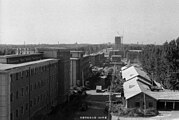Kenkoku Daigaku | |
 The campus of Kenkoku University. | |
Former names | The Manchurian University |
|---|---|
| Motto | Chinese: "五族協和" Japanese: "ごぞくきょうわ" Korean: "오족협화" |
Motto in English | "Five races under one union" |
| Type | Public research university |
| Established | May 1938 |
| Chancellor | Ishiwara Kanji |
| Vice-Chancellor | Sakata Shoichi (1938—1942) Kamezo Odaka (1942—1945) |
| Location | , |
| Campus | Urban |
| Colours | |
| Mascot | Kanto Star (関東の星) |
 | |
Kenkoku Daigaku or simply Kendai [ˈkɛndaɪ] was an educational institution in Xinjing (modern Changchun, Jilin province), the capital of Manchukuo, the Japanese puppet state in occupied Manchuria during the Second Sino-Japanese War. It operated from May 1938 to August 7, 1945.[1]
The university was founded in 1938 by General Kanji Ishiwara, and was run by Professor Shoichi Sakuda of Kyoto University.[2] Its purpose was to promote "ethnic harmony" in the region, legitimising and promoting the Japanese occupation.[3] To this end, students were recruited from Japan, China proper, Mongolia, Taiwan, Manchuria, Korea and Russia.[4] As well as offering free tuition, the University also provided its students with board and lodgings, and a stipend.[5]
The university closed in 1945 when the Kwantung Army were beaten by Soviet red army.[2]

A number of influential aikido practitioners trained and taught at the University, including aikido's founder Morihei Ueshiba,[6] Kenji Tomiki, Shigenobu Okumura and Noriaki Inoue.[7]

Multiple students of Kenkoku University later became prominent political figures in South Korea—including later South Korean prime minister Kang Young-hoon—, North Korea and China.[8] The first test for applicants within Joseon was held at Gyeongseong Women's Normal School in Susong-dong for three days starting on December 27. It was unusual that the physical examination was the first. He said : "If you want to work in Manchuria, you must first be physically healthy, so consider your health first" (Entrance Exam Suffering No. 1, Chosun Ilbo, December 28, 1937). Of the 670 applicants, 90 (60 Koreans and 30 Japanese) were selected. The competition rate was 7.4 to 1.
-
Stamp of Kenkoku Shrine, 1942
-
On August 23, 1964, Zhou Peiyuan (middle) accompanied Mao Zedong (left) to meet with Sakata Shoichi (right), as the head of the Japanese delegation
-
1984 Yan'an Street, Changchun City
-
Site of Ministry of Culture and Education Development of Manchukuo. Original building demolished. Now Primary School Attached to Northeast Normal University
-
Library of Xinjing Branch of South Manchurian Railway Co
- ^ Ebrey, Patricia Buckley (1996), The Cambridge Illustrated History of China, New York, pp. 282, ISBN 0-521-66991-X
{{citation}}: CS1 maint: location missing publisher (link) - ^ a b Kevin Doak (2007). A History of Nationalism in Modern Japan: Placing the People. BRILL. p. 241. ISBN 978-90-04-15598-5.
- ^ David H. Price (May 19, 2008). Anthropological Intelligence: The Deployment and Neglect of American Anthropology in the Second World War. Duke University Press. pp. 69–70. ISBN 978-0-8223-8912-5.
- ^ Hiruma Kishida, Yuka (2019). Kenkoku University and the Experience of Pan-Asianism. Bloomsbury Academic. ISBN 9781350057869.
- ^ Tatsuhiko, Yoshizawa. "The Manchurian Incident, the League of Nations and the Origins of the Pacific War. What the Geneva archives reveal". Japan Focus. Asia-Pacific Journal. Retrieved December 5, 2013.
- ^ Stevens, John (1999). Invincible Warrior: A Pictorial Biography of Morihe Ueshiba, the Founder of Aikido. Boston, London: Shambhala. p. 63. ISBN 9781570623943.
- ^ Pranin, Stanley. "Interview with Shigenobu Tomura". Aiki Journal. Archived from the original on December 16, 2013. Retrieved December 5, 2013.
- ^ Leung, Ernest Ming-tak (August 20, 2021). "The School That Built Asia". Palladium. Retrieved October 22, 2021.




